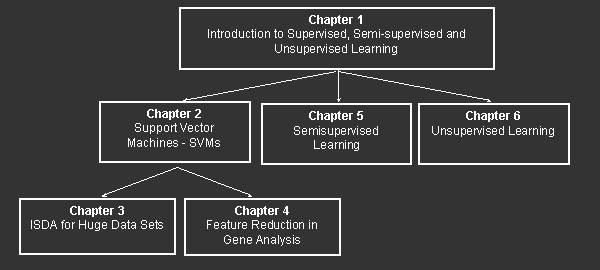| Chapter
Survey

This
book is divided into 6 chapters and the structure of the book is
shown in the figure above.
The basic motivations
and presentation of three different approaches in solving three
unlike learning from data tasks are given in Chap.
1. It is a kind of both the background and the stage for
a book to evolve.
Chapter
2 introduces the constructive part of the SVMs without
going into all the theoretical foundations of statistical
learning theory which can be found in many other books. This may
be particularly appreciated by and useful for the applications
oriented readers who do not need to know all the theory back to
its roots and motives. The basic quadratic programming (QP)
based learning algorithms for both classification and regression
problems are presented here. The ideas are introduced in a
gentle way starting with the learning algorithm for classifying
linearly separable data sets, through the classification tasks
having overlapped classes but still a linear separation
boundary, beyond the linearity assumptions to the nonlinear
separation boundary, and finally to the linear and nonlinear
regression problems. The appropriate examples follow each model
derived, just enabling in this way an easier grasping of
concepts introduced. The material provided here will be used and
further developed in two specific directions in Chaps. 3 and 4.
Chapter
3 resolves the crucial problem of the QP based learning
coming from the fact that the learning stage of SVMs scales with
the number of training data pairs. Thus, when having more than
few thousands data pairs, the size of the original Hessian
matrix appearing in the cost function of the QP problem setting
goes beyond the capacities of contemporary computers. The fact
that memory chips are increasing is not helping due to the much
faster increase in the size of data files produced. Thus, there
is a need for developing an iterative learning algorithm that
does not require a calculation of the complete Hessian matrix.
The Iterative Single Data Algorithm (ISDA) that in each
iteration step needs a single data point only is introduced
here. Its performance seems to be superior to other known
iterative approaches.
Chapter
4 shows how SVMs can be used as a feature reduction tools
by coupling with the idea of recursive feature elimination. The
Recursive Feature Elimination with Support Vector Machines (RFE-SVMs)
developed in Guyon et all. (2002) is the first approach that utilizes the idea of
margin as a measure of relevancy for feature selection. In this
chapter, an improved RFE-SVM is also proposed and it is applied
to the challenging problem of DNA microarray analysis. DNA
microarray is a powerful tool which allows biologists to measure
thousands of genes’ expression in a single experiment. This
technology opens up the possibility of finding out the causal
relationship between genes and certain phenomenon in the body,
e.g. which set of genes is responsible for certain disease or
illness. However, the high cost of the technology and the
limited number of samples available make the learning from DNA
microarray data a very difficult task. This is due to the fact
that the training data set normally consists of a few dozens of
samples, but the number of genes (i.e., the dimensionality of
the problem) can be as high as several thousands. The results of
applying the improved RFE-SVM to two DNA microarray data sets
show that the performance of RFE-SVM seems to be superior to
other knownapproaches such as the nearest shrunken centroid
developed in Tibshirani et. all. (2002).
back
to top
Chapter
5 presents two very promising semi-supervised learning
techniques, namely, GRFM and CM. Both methods are based on the
theory of graphical models and they explore the manifold
structure of the data set which leads to their global
convergence. An in depth analysis of both approaches when facing
with unbalanced labeled suggests that the performance of both
approaches can deteriorate very significantly when labeled data
is unbalanced (i.e., when the number of labeled data in each
class is different). As a result, a novel normalization step is
introduced to both algorithms improving the performance of the
algorithms very significantly when faced with an unbalance in
labeled data. This chapter also presents the comparisons of CM
and GRFM with the various variants of transductive SVMs (TSVMs)
and the results suggest that the graph-based approaches seem to
have better performance in multi-class problems.
Chapter
6 introduces two basic methodologies for learning from
unlabeled data within the unsupervised learning approach: the
Principal Component Analysis (PCA) and the Independent Component
Analysis (ICA). Unsupervised learning is related to the
principle of redundancy reduction which is implemented in
mathematical form through minimization of the statistical
dependence between observed data pairs. It is demonstrated that
PCA, which decorrelates data pairs, is optimal for Gaussian
sources and suboptimal for non-Gaussian ones. It is also pointed
to the necessity of using ICA for non-Gaussian sources as well
as that there is no reason for using it in the case of Gaussian
ones. PCA algorithm known as whitening or sphering transform is
derived. Batch and adaptive ICA algorithms are derived through
the minimization of the mutual information which is an exact
measure of statistical (in)dependence between data pairs. Both
PCA and ICA derived unsupervised learning algorithms are
implemented in MATLAB code, which illustrates their use on
computer generated examples.
back to top
|